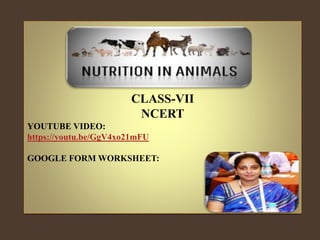
NUTRITION IN ANIMALS -2 (CLASS-VII) NCERT
- 2. In the previous class we learned that plants can prepare their own food by photosynthesis but animals cannot. Animals get their food from plants, either directly by eating plants or indirectly by eating animals that eat plants. So animals exhibit heterotopic mode of nutrition.
- 3. All the animals can be divided into three groups on the basis of their food habits. These are: Herbivores: Those animals which eat only plants are called herbivores. Examples are Goat, Cow, and Deer etc. Carnivores: Those animals which eat only other animals as food are called carnivores. Examples are Lion, Tiger, and Lizard etc. Omnivores: Those animals which eat both, plants and animals are called omnivores. Examples are Man, Dog and deer etc.
- 4. Holozoic Nutrition: It is a process by which animals take in their food. It involves different steps namely, ingestion, digestion, absorption, assimilation and egestion. Human beings exhibit holozoic mode of nutrition involving five basic steps. Ingestion: The process of taking food into the body is called ingestion. Digestion: the process in which the food containing large, insoluble molecules is broken down into small, water soluble molecules is called digestion. Absorption: The process in which the digested food passes through the intestinal wall into blood stream is called absorption. Assimilation: The process in which the absorbed food is taken in by the body cells and used for energy, growth and repair is called assimilation. Egestion: The process in which the undigested food is removed from the body is called egestion.
- 5. Nutrition in Amoeba: Amoeba is a microscopic organism which consists of only a single cell. Amoeba is mostly found in pond water. Amoeba eats tiny plants and animals as food which floats in water in which it lives. The mode of nutrition in Amoeba is holozoic. The process of obtaining food by Amoeba is called phagocytosis. Amoeba ingests food by forming temporary finger-like projections called pseudopodia around it. The food is engulfed with a little surrounding water to form a food vacuole (‘temporary stomach’) inside the Amoeba.
- 6. In Amoeba, food is digested in the food vacuole by digestive enzymes which break down the food into small and soluble molecules by chemical reactions. Then digested simple and soluble substances pass out of food vacuole into the surrounding environment.
- 7. Nutrition in Paramecium: Paramecium is also a tiny unicellular animal which lives in water. Ingestion: Paramecium uses its hair like structures called cilia to sweep the food particles from water and put them into mouth. Ingestion is followed by other steps such as digestion, absorption, assimilation and egestion which are same as those we studied in Amoeba
- 8. Nutrition in Hydra Hydra is a simple multicellular animal. It has a number of tentacles around its mouth, which are used for ingestion of food. These tentacles entangle small aquatic animals and kill them with their stinging cells. After this they push them into their mouth. Now inside their body cavity digestive juices are secreted by the surrounding cells. These juices digest the food and the digested food is absorbed through the cavity walls and assimilated in the cells.
- 9. Nutrition in Spider In spiders digestion of food actually takes place outside their body. A spider weaves a sticky web in which small insects get stuck. It then injects digestive juices into the body of the insect, which digests the body part of the insects. The spider then sucks up the digested food.
- 10. Nutrition in Frog The frog uses its long sticky tongue to catch insects. Frogs have well developed digestion system in which the digestion of food takes place.
- 11. Ruminants are mammals that are able to acquire nutrients from plant- based food. There are roughly 150 species of ruminants that include both domestic and wild species. Ruminating mammals include cattle, goats, sheep, giraffes, yaks, deer, antelope etc. In this section, you will learn about the digestion process in ruminants.
- 12. Digestion process in Ruminants Dentition in ruminants: Dentition is quite different in rumination. Incisors are absent on the upper jaw. Canines are absent in both the jaws. Molars are very strong as these animals, chew the cud.
- 13. Rumination: Ruminants swallow the food without chewing. After feeding, they bring the food from the stomach back into the mouth and chew it leisurely. This process is called rumination and such animals are called as ruminants. Rumination is also called as second chewing.
- 14. Grass-eating animals swallow the food quickly and store it in the rumen. Rumen also inhabits cellulose digesting bacteria which establish a symbiotic relationship with the animal stomach. Digestion in ruminants is a good example of symbiosis. Microorganisms present in the stomach of ruminants help in digesting cellulose and in turn obtain shelter and nourishment form the animal. A symbiotic relationship exists between microorganisms and the ruminants.
- 15. As rumen is full, the food is taken into second part of the stomach, the reticulum. Digestive juices of the reticulum partially digest the food. The partially digested food in the reticulum is called as cud. While resting, cow brings back the cud into the mouth for regurgitation. Food is chewed completely and swallowed into abomasum for further digestion. Then the food moves into abomasum for digestion brought about by digestive juices. A large sac-like structure called the caecum lies between the small and large intestines.
- 16. The symbiotic bacteria present in the caecum help in the complete digestion of cellulose. Digestion of food is completed in the intestine. As the symbiotic bacteria are not present in the human digestive system, humans cannot digest cellulose.
